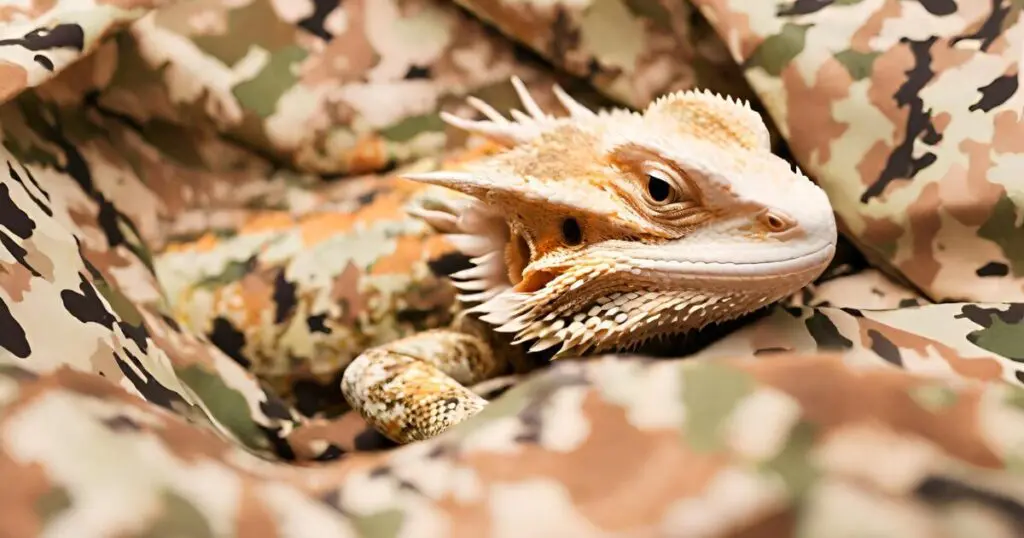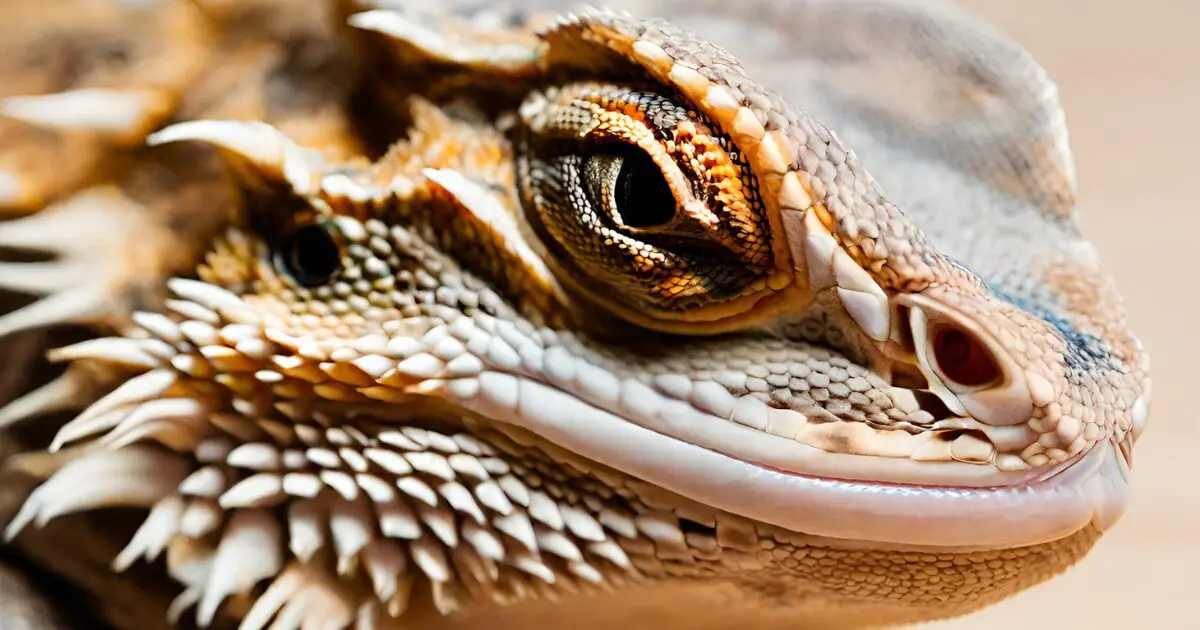It’s better to learn about an animal properly before adopting them as pets. One common question regarding beardies is, “Do bearded dragons have scales?” This seems obvious at first glance, but it’s worth exploring in more detail with evidence.
In short, yes, bearded dragons are covered in scales from head to toe. Their scales help protect them from the sun, prevent moisture loss, and defend them from predators. The scales grow in rows and overlap each other like shingles on a roof. They come in a variety of colors and patterns.
Read on to learn more about these unique reptiles and their scaly skin. Understanding their biology better helps me care for Spike and share fun facts with fellow reptile lovers.
What Do Bearded Dragons Scales Look Like?
The variation in beardies’ colors, shapes, and sizes gives them a unique look. Their scales help protect them from predators and prevent moisture loss.
- Colors: Scales can be tan, brown, gray, reddish, yellow, or black. Some have patterns like spots, bands, or a reddish beard. The colors and patterns provide camouflage in their native Australian habitat.
- Shape: The scales have a diamond-like shape and grow in rows from head to tail. They overlap each other like shingles.
- Sizes: Scales near the spine and legs tend to be larger. Scales on the head, neck, and sides are smaller.
- Texture: The scales feel rough and leathery to the touch. Older scales get worn down over time.
- Shedding: Bearded dragons shed their scales in sections as they grow. This is called ecdysis. Shedding helps remove parasites and keeps the scales in good condition.
Benefits of Having Scales for Bearded Dragons
Scales provide important protections and advantages for bearded dragons. This unique reptilian armor suits the dragons’ lifestyle and environment.
1. Camouflage
The scales’ tan, brown, and black coloring helps these lizards blend into the desert sands and rocky outcroppings of Australia. It helps them avoid predators and surprise prey. The patterns and colors of the scales disguise the dragons in their native habitat. Camouflage is an important aspect of their survival.

Also Read: Do Bearded Dragons Bite Hurt?
2. Armor
The hard, thick scales act as a suit of armor against attacks. They shield dragons’ bodies from scratches, scrapes, and bites. The overlapping rows prevent injuries from penetrating the skin. They need this protection in their natural habitat to stay safe from sharp rocks and thorns.
3. Heat Regulation
The scales reflect sunlight to prevent overheating. Darker scales also help absorb heat from the sun’s rays. This helps bearded dragons stay warm as they bask in the sun. Without sufficient heat, bearded dragons may suffer from-
- Weakened immune system
- Reduced activity
- Metabolic issues, and
- Difficulty regulating body temperature
4. Moisture Retention
The scales prevent water loss through the skin. Their water-resistant surface keeps moisture inside the dragon’s body in the dry desert climate. Without the protection of the scales, bearded dragons would quickly become dehydrated. Lack of moisturization can lead to various problems, such as:
- Insufficient moisture may result in dry, flaky skin, which may make shedding difficult
- Dry air can irritate the respiratory tract
- A lack of moisture retention can disrupt their ability to thermoregulate effectively.
- Prolonged dehydration due to lack of moisture can strain internal organs.
5. Friction and Grip
The rough texture of the scales gives dragons friction to grip branches and rocks. This helps them climb effectively. Wondering if bearded dragons can climb walls? Yes, they can. The tiny ridges and grooves on each scale create just enough roughness for traction to hold on.
6. Injury Recovery
Scales allow minor injuries to heal underneath them. Damaged scales can be shed and replaced through the process of ecdysis. Replacing injured scales helps prevent infection or further damage.
7. Communication
Bearded dragons can change the color of their scales to signal aggression, show submission, and communicate breeding readiness. By altering blood flow to the scales, the dragons display different temporary color patterns.
Why Do Bearded Dragons Lose Scales?
Bearded dragons can lose their scales for various reasons. Sometimes, it can be all-natural, while sometimes, it can be a concern.
1. Shedding
Bearded dragons shed their scales as they grow. Young dragons may shed every 4-6 weeks as juveniles. Adults shed less frequently, around every 2-3 months. Shedding, called ecdysis, allows dragons to replace damaged scales and remove parasites.
The process begins as the old outer layer of scales. Dragons become pale as the inner skin shows through the detaching outer layer. Within a few days, scales are shed off in patches or full sections. Shedding usually begins at the head and then moves down the body and tail.
You can help them with the process. Provide a rough surface for them to rub against, like rock slates. Mist them gently with water as well. Avoid pulling at loose scales, as it can tear the skin. The scales should come off on their own.
2. Injury
Bearded dragons can lose scales due to injuries. Improper handling falls, or cuts can damage scales. If the skin beneath is not harmed, new scales will replace lost ones at the next shed. Severe injuries may leave permanent bare patches if the skin is too damaged to regrow scales.
Prevent injuries by handling beardies properly. Make sure their habitat has smooth surfaces. Check for wounds if your dragon is rapidly losing scales. Remove sharp decor items that could scrape them.
3. Mites
Parasitic mites that feed on skin and scales may infest dragons. Mites cause intense itching. It may lead dragons to scratch off scales while trying to relieve irritation. This patchy scale loss is accompanied by small black “dirt” specks around the ears or neck.
- Treat mites with veterinarian-prescribed medication.
- Disinfect the habitat to eliminate the pests.
- Ensure proper husbandry to avoid conditions favoring mites.
How to Prevent Scale Loss for Bearded Dragons?
While some shedding is normal, scale loss can also result from improper care. Follow these tips to maintain healthy scales:
- Ensure proper nutrition. Feed a varied diet with adequate calcium to support scale growth. Avoid poor diets that cause metabolic bone disease.
- Prevent impaction. Impaction from substrate or poor diet causes scale loss from belly rubbing. Use appropriate loose substrate; never calcium-sand.
- Check habitat decor. Remove sharp rocks or branches that could scrape off scales. Ensure basking areas are smooth.
- Maintain ideal temperatures. Heat lamps and proper heating keep dragons from getting too cold, which stresses their scales.
- Avoid overhandling. Reduce stress from excessive handling that may cause dragons to rub off scales.
- Check for shed issues. Help dragons remove the stuck shed. Retained shed can pull off healthy scales when it detaches.
- Prevent mites. Disinfect the enclosure and decor fully to kill mites. Treat dragons promptly if mites are detected.
- Allow minor injuries to heal. Small lost scales from cuts will likely regrow at the next shed. Avoid injury-prone decor.
- Handle gently and support the body. Prevent falls and mishandling stress. Always support your legs and body properly when handling. Check this article to learn how to handle bearded dragons.
FAQ
Is bearded dragon scale rot contagious?
No, bearded dragon scale rot is not contagious between dragons. It is caused by poor husbandry practices. It can be inadequate enclosure hygiene or improper humidity levels. However, it can spread internally if left untreated.
Can beardies feel touch over the scales?
Yes, bearded dragons can feel touch over their scales. While their scales provide protection, they also have sensory receptors in their skin. This allows them to perceive touch, pressure, and other tactile sensations. This sensitivity helps them navigate their environment and respond to stimuli.
What is the normal color for bearded dragons’ scales?
The normal color of bearded dragons’ scales can vary depending on their species. Common colors include shades of brown, tan, gray, and green. Some may also exhibit vibrant hues like red, orange, or yellow.
Can bearded dragons change their scale color?
Yes, bearded dragons can change their scale color slightly. It depends on various factors, such as temperature, mood, and environmental conditions. They may darken or lighten their colors to regulate body temperature, camouflage, or communicate.
Final Thought on Do Bearded Dragons Have Scales
Bearded dragons are covered from nose to tail tip in armor-like scales. These unique reptiles rely on their hardy scales for protection, heat control, and other benefits. Though scales shed and regrow throughout a dragon’s life, excessive loss can be problematic.
Minor lost scales will regenerate at the next shed cycle. Ensure your bearded dragon’s scales stay intact to maintain good health. Overall, these scaly skins are a beneficial part of the bearded dragon’s anatomy. It enables them to thrive in Australia’s harsh deserts.
